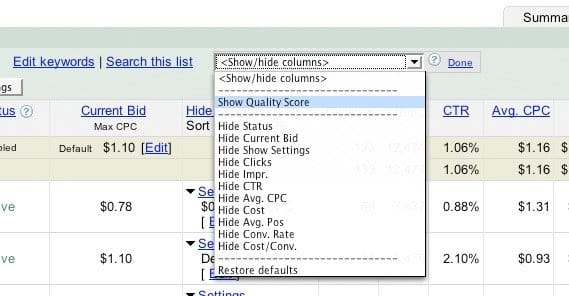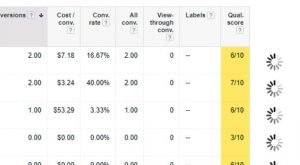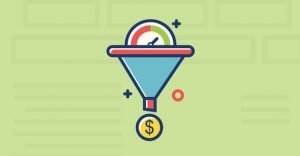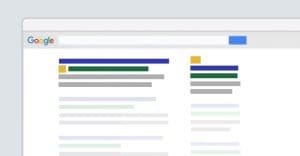How to Increase Your Google AdWords Quality Score

On AdWords, every keyword you target is assigned a quality score. This quality score is an analysis by Google, using a whole bunch of factors they don’t really reveal. In general, it’s an indication of how relevant and useful your ad copy and landing page is for that keyword.
Google’s example uses socks. You’re a store that sells socks. A user plugs “striped socks” into Google and sees your ad. There are three ways your ad could appear here; one specifically mentioning striped socks, one mentioning socks in general, and one that doesn’t mention socks at all. The striped socks one would have the best quality score, while the one that doesn’t mention socks at all would have the worst.
Now say the customer clicks that ad and lands on your landing page. The lowest quality score option would be your homepage. A better option would be a socks category page. The best option might be a page specifically about the striped socks you offer.
Having a better quality score gives you some benefits with AdWords. Ads with a higher quality score tend to have better CTRs and conversion rates. They also qualify you for better rates in the ad auctions, because you’re known for being very accurate. A higher quality score will also place your ad higher in the sponsored results, when relevant.
Checking Quality Score
There are two ways to check the quality score of your ads. They both require you to go into your ads manager and visit the keywords tab.
For the first method, click the campaigns tab, click the keywords tab, and then click the white speech bubble next to any given keyword. This will give you a page with statistics about that keyword, which include your ad relevance, your landing page experience rating, your estimated CTR with the ad based on historical data, and your quality score.
The second method is in the same place, in the keywords tab. Look for the column labeled qual score. If it doesn’t exist, click the columns menu and click customize. Select attributes, click to add qual score, and save. This will show your quality score – without the other data from the first method – right on your keywords report.
Quality scores are measured from 1 to 10, where 10 is the best possible score. You don’t want to see a 1.
Types of Quality Score
The quality score explained above is just one of many types of quality score. I picked it because it’s the most granular level, at the keyword level. You also have:
- An account-level quality score that aggregates the quality score of all of your ads and keywords, mixes it with historical data, and gives you an account-wide average.
- The ad group quality score, which works on a within-campaign level to give you an idea of how your ads are performing.
- The ad-level quality score, which shows you data about your ads specifically, regardless of which keywords are included and their individual quality scores.
- Your landing page quality score, which is an estimate of the quality of your landing page, based on its relevance to your targeted keywords, its transparency, and it’s ease of use.
- Your display network quality score, which works with ads outside of the Google search results.
- Your mobile quality score, which deals specifically with your suitability for mobile users and goes all the way past your landing page and into your conversion process.
Boosting Your Quality Scores
If you’re confused, don’t be. Sure, there are a lot of quality scores attached to everything, but it’s really not all that complex. Just be better at PPC and you’ll earn higher quality scores.
First, look at any existing quality scores you have, and find the worst of them. Why are they listed as low as they are? Try to dig down to the ad or keyword level; improving those will improve your overall mobile/account quality scores. Sometimes, Google will tell you why your quality score is as low as it is. Try to address the issue.
If there’s no reason given – and there generally isn’t, if your quality score is around 4-6 – you need to apply a little critical thinking. Ask yourself questions:
- What is the keyword for this ad?
- Have I written copy that’s relevant to that keyword?
- Is my landing page as relevant as possible for that keyword?
- Is the page useful for people searching for that keyword?
Any quality score under 8 is a quality score that has some flaw in one of those questions. Figure out how you can improve the ad and implement those changes.
Almost always, when you have a low quality score, it’s a disconnect between the keywords and the copy that makes users not want to click the ad. Google really likes it when users click ads, and thus your CTR is the single biggest factor deciding your quality score. Work to improve CTR, typically through testing ad copy, and your quality scores will improve. Thankfully, quality score isn’t at odds with other business objectives, so it’s beneficial to do both.
Diagnosing Abrupt Drops
Did your quality scores tank overnight? There are a few possible issues. For one thing, check the destination landing page. If the URL is broken or the page doesn’t work, your quality score is going to drop. Thankfully, it will go back up once you fix the problem.
A more problematic issue is the 10-1 drop. This is typically called a Google Slap, and it’s Google more or less telling you there’s something wrong with your site or your business model. It often happens with sites identified as spam; Google doesn’t want to serve spam or scam sites to its users. If you earn this flag, you’re probably out of luck. Very rarely there’s a legitimate misunderstanding you can get cleared up, but most of the time you’ll have to put a lot of work into revamping your business model just to try again.
 ContentPowered.com
ContentPowered.com





